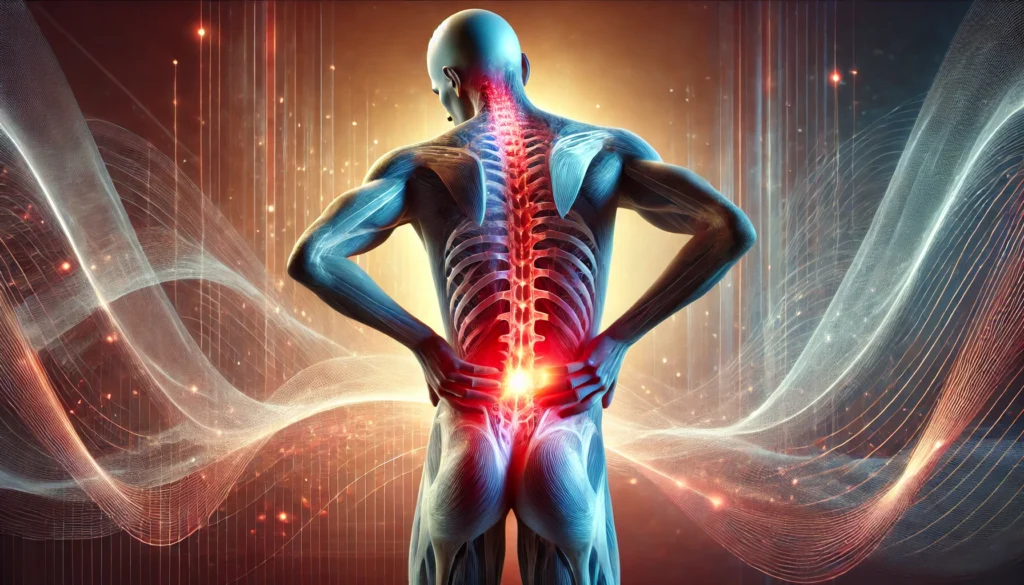Experiencing back and body pain can be incredibly frustrating and can affect your quality of life. Whether it’s a dull ache or sharp discomfort, persistent pain in the back and body may hinder daily activities and overall well-being. Understanding the potential causes of this pain and knowing how to address it can help you find relief and prevent future discomfort. In this article, we will explore common reasons for back and body pain and offer practical tips for managing and preventing it.
Common Causes of Back and Body Pain
Poor Posture
One of the most common causes of back and body pain is poor posture. Sitting or standing with poor alignment can strain your muscles, ligaments, and joints, leading to discomfort. For example, slouching at a desk or hunching over your phone for extended periods can result in pain in the back, neck, and shoulders.
Read Also: Worst Sleeping Position for Lower Back Pain – Sleep Positions That Worsen Lower Back Pain!
Muscle Strain or Overuse
Overexerting your muscles through heavy lifting, intense exercise, or repetitive movements can lead to muscle strain. When muscles are overstressed, they become inflamed and sore, causing pain throughout the body, including the lower back, shoulders, and neck.
Herniated Discs
A herniated disc occurs when the soft tissue between the vertebrae of the spine slips out of place, pressing on nearby nerves. This condition often causes severe back pain and can radiate down the legs or affect other parts of the body, depending on where the disc is located.
Arthritis
Both osteoarthritis and rheumatoid arthritis can contribute to back and body pain. Inflammation of the joints can cause stiffness, swelling, and discomfort, particularly in the lower back, hips, and knees.
Inactivity or Sedentary Lifestyle
A lack of physical activity can weaken muscles and make the body more prone to pain. Prolonged sitting, such as working at a desk for hours or watching TV, can lead to stiffness and discomfort in the back and other areas of the body.
Stress and Tension
Mental stress often manifests physically, leading to tension in the muscles. The back and neck muscles, in particular, can become tight and sore as a response to stress, leading to aches and discomfort.
Injury or Trauma
Accidents, falls, or sudden movements can result in back or body injuries, causing immediate pain. These injuries might involve the muscles, ligaments, discs, or bones of the spine and can lead to long-term discomfort if not treated properly.
How to Relieve Back and Body Pain

Practice Good Posture
Improving your posture can go a long way in preventing and reducing back and body pain. Make sure to stand tall, keep your shoulders back, and align your ears with your shoulders. When sitting, use a chair with good lumbar support and avoid slouching.
Exercise Regularly
Regular physical activity can strengthen muscles, improve flexibility, and alleviate tension. Incorporate low-impact exercises like walking, swimming, or yoga to keep your body moving and support your spine.
Apply Heat or Cold Therapy
Using heat pads or ice packs on the affected area can help reduce inflammation, relax muscles, and provide temporary relief. Apply ice for 20 minutes in the acute phase of pain and heat for chronic muscle soreness.
Massage Therapy
A gentle massage can help reduce muscle tightness and improve circulation, promoting relaxation and pain relief. Consider seeing a licensed massage therapist or using a foam roller at home for self-massage.
Stretch and Strengthen
Regular stretching and strengthening exercises can improve flexibility and reduce muscle tension. Focus on stretches that target the lower back, shoulders, and neck, and work on strengthening core muscles to support your spine.
Take Breaks and Move
If you have a sedentary job, remember to take breaks throughout the day. Stand up, stretch, and walk around to keep your muscles from becoming stiff. Try to avoid sitting for prolonged periods and use a standing desk if possible.
Consult a Doctor or Physical Therapist
If your back and body pain persists or becomes severe, it’s essential to seek professional help. A doctor or physical therapist can diagnose the underlying cause of your pain and recommend personalized treatments, including exercises, medications, or therapy.
How to Prevent Back and Body Pain
Maintain a Healthy Weight
Excess weight, particularly around the abdomen, can put extra strain on the back and joints. Maintaining a healthy weight through proper diet and exercise can help reduce the risk of back and body pain.
Sleep on a Supportive Mattress
A mattress that offers the right amount of support for your spine is crucial for reducing back pain. Avoid sleeping on a mattress that is too soft or too firm—find one that provides adequate support while still being comfortable.
Lift Properly
When lifting heavy objects, always bend your knees and lift with your legs, not your back. Avoid twisting your body while lifting, as this can cause strain on your spine and muscles.
Manage Stress
Practice stress-management techniques like deep breathing, meditation, or mindfulness to reduce the physical effects of stress on your body. Reducing stress can help prevent muscle tension and discomfort.
Stay Hydrated and Nourished
Drinking enough water and eating a balanced diet can help keep your muscles and joints healthy. Proper hydration supports your muscles, while anti-inflammatory foods like fruits, vegetables, and omega-3 rich foods can help reduce pain and inflammation.
FAQs:
1 What causes back and body pain?
Common causes include poor posture, muscle strain, herniated discs, arthritis, and stress.
2 How can I relieve back and body pain?
Relief can be achieved through good posture, regular exercise, stretching, and heat or cold therapy.
3 Can stress cause back and body pain?
Yes, stress can lead to muscle tension, especially in the back and neck, contributing to pain.
4 How can I prevent back and body pain?
Maintain a healthy weight, use proper lifting techniques, exercise regularly, and manage stress.
5 When should I see a doctor for back and body pain?
Consult a doctor if the pain is persistent, severe, or doesn’t improve with self-care methods.
Conclusion:
Back and body pain is a common issue that can arise from various causes, including poor posture, muscle strain, arthritis, and inactivity. Fortunately, with the right strategies, you can manage and alleviate the discomfort. Incorporating healthy habits like regular exercise, good posture, and stress management can significantly reduce your risk of experiencing pain. If your pain persists or worsens, be sure to consult a healthcare professional for personalized treatment.By taking proactive steps, you can find relief from back and body pain, improve your daily comfort, and prevent future issues.
Read More Relevant Article:
- Read Also: Upper Back Pain During Pregnancy: Causes, Relief, and Prevention Tips – Managing Upper Back Pain During Pregnancy!
- Read Also: Upper Back Pain Between Shoulder Blades – Pain in the Upper Back Between the Shoulder Blades!
- Read Also: Qi Gong for Upper Back Pain: A Natural Approach to Healing and Relief – Using Qi Gong to Relieve Upper Back Pain!











